 El origen de Chipiona se remonta a los Tartesos, cuando su población se asentaba en terrenos próximos a la Piedra de Salmedina. Esta civilización debió extenderse entre los siglos IX y VI a.C., afianzando su Imperio en el sur de España, concretamente en lo que hoy es Chipiona, el Puerto de Santa María, El Portal y Trebujena, y que ellos llamaron la isla Kartare.
El origen de Chipiona se remonta a los Tartesos, cuando su población se asentaba en terrenos próximos a la Piedra de Salmedina. Esta civilización debió extenderse entre los siglos IX y VI a.C., afianzando su Imperio en el sur de España, concretamente en lo que hoy es Chipiona, el Puerto de Santa María, El Portal y Trebujena, y que ellos llamaron la isla Kartare. Pero pasó el tiempo, llegaron los romanos y el cónsul Quinto Servilius Caepión (140-139 a.C) construyó una especie de faro para prevenir que los navegantes, que tenían que entrar al Guadalquivir, tuvieran un "encontronazo" indeseado con el islote de Salmedina. Con Turris Caepionis -en honor a su promotor Caepio- bautizaron la torre y así se fue gestando el nombre de la actual Chipiona.
Pero pasó el tiempo, llegaron los romanos y el cónsul Quinto Servilius Caepión (140-139 a.C) construyó una especie de faro para prevenir que los navegantes, que tenían que entrar al Guadalquivir, tuvieran un "encontronazo" indeseado con el islote de Salmedina. Con Turris Caepionis -en honor a su promotor Caepio- bautizaron la torre y así se fue gestando el nombre de la actual Chipiona.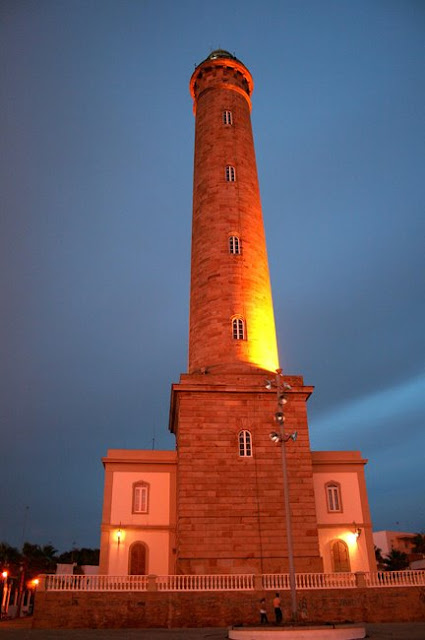
Curiosamente, el Faro de Chipiona -construido entre 1863 y 1867- es el más alto de España y uno de los más altos de Europa - de 69 metros y 344 escalones para subir a la linterna-.
La Chipiona romana se convirtió en un lugar estratégico para el comercio fluvial del Guadalquivir y marítimo de Cádiz (conocida por aquel entonces como Gades) donde florecía la economía de la Hispania romana gracias a la exportación de productos agrícolas: vid, olivo, cereales; metales; y salazones de Cádiz, principalmente. Como testigo de estas actividades económicas todavía se conserva el alfar de El Olivar y cerca del faro, los muros de una villa romana del siglo I d.C.
 Otra curiosidad, que sirve de testimonio de la presencia romana en la city, son las lápidas y tumbas, que de vez en cuando se han encontrado en la playa de Regla -una zona de la costa chipionera cerca del Santuario del que hablaremos luego- expulsadas del mar por las mareas.
Otra curiosidad, que sirve de testimonio de la presencia romana en la city, son las lápidas y tumbas, que de vez en cuando se han encontrado en la playa de Regla -una zona de la costa chipionera cerca del Santuario del que hablaremos luego- expulsadas del mar por las mareas. Otro descubrimiento histórico fue la necrópolis infantil ( s.I-III d.C.) con veinte enterramientos en ánforas seccionadas, que salió a la luz tras el derribo de un viejo chalet. Siguiendo el recorrido histórico llegamos a la época musulmana de la que poco se conoce en Chipiona porque no hay apenas testigos documentales. Lo que si se sabe es que existió una mezquita, probablemente donde ahora está la Parroquia de Nuestra Señora de la O, que pasó de ser gótica a dejarse impregnar por el barroco, con lo que terminó siendo un híbrido de gran belleza. En su interior, destacan: la sillería del coro (s. XVIII), el reloj de la torre (s. XIX) y la escultura gótica de la Virgen de la Rosa -perteneciente a la Escuela Borgoñona Sevillana- hecha por Pedro de Millán a principio de s. XVI.
Otro descubrimiento histórico fue la necrópolis infantil ( s.I-III d.C.) con veinte enterramientos en ánforas seccionadas, que salió a la luz tras el derribo de un viejo chalet. Siguiendo el recorrido histórico llegamos a la época musulmana de la que poco se conoce en Chipiona porque no hay apenas testigos documentales. Lo que si se sabe es que existió una mezquita, probablemente donde ahora está la Parroquia de Nuestra Señora de la O, que pasó de ser gótica a dejarse impregnar por el barroco, con lo que terminó siendo un híbrido de gran belleza. En su interior, destacan: la sillería del coro (s. XVIII), el reloj de la torre (s. XIX) y la escultura gótica de la Virgen de la Rosa -perteneciente a la Escuela Borgoñona Sevillana- hecha por Pedro de Millán a principio de s. XVI. También se cree que el Castillo - que ha pasado de tener uso residencial a defensivo y hasta a ser un hostal- fue construido por los musulmanes y hacia 1295 Don Alonso Pérez de Guzmán lo reconstruyó sobre sus cimientos, regalándoselo posteriormente a su segunda hija Doña Isabel. Recientemente restaurado, el edificio se cimenta sobre un firme rocoso natural, batido por las olas del mar cuando sube la marea.
También se cree que el Castillo - que ha pasado de tener uso residencial a defensivo y hasta a ser un hostal- fue construido por los musulmanes y hacia 1295 Don Alonso Pérez de Guzmán lo reconstruyó sobre sus cimientos, regalándoselo posteriormente a su segunda hija Doña Isabel. Recientemente restaurado, el edificio se cimenta sobre un firme rocoso natural, batido por las olas del mar cuando sube la marea.
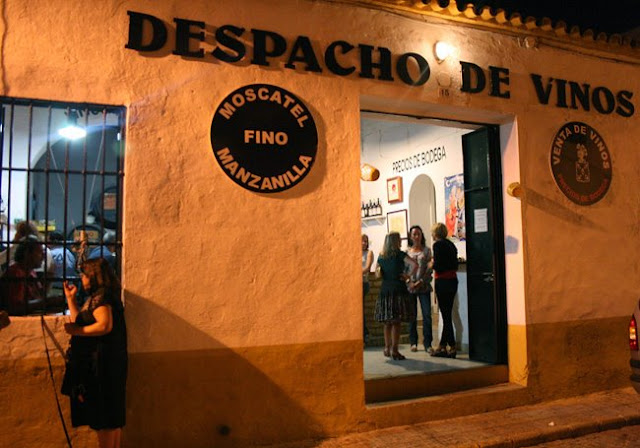 Don Alonso, protagonista de la Reconquista, fue el encargado de repoblar Chipiona trayendo a varias familias de los pueblos de Marchena (Sevilla), Arcos (Cádiz) y otros lugares para tal fin, pues según cuentan las crónicas: "En 1295 el rey D. Sancho IV dio a D. Alonso Pérez de Guzmán el Bueno, jefe de la tropa y plaza de Tarifa, toda la tierra que había en la costa entre Guadalquivir y Guadalete, en la que se incluían Sanlúcar, Chipiona, Rota y el Puerto de Santa María, cuyos términos se tomaron de los que poseía Jerez".
Don Alonso, protagonista de la Reconquista, fue el encargado de repoblar Chipiona trayendo a varias familias de los pueblos de Marchena (Sevilla), Arcos (Cádiz) y otros lugares para tal fin, pues según cuentan las crónicas: "En 1295 el rey D. Sancho IV dio a D. Alonso Pérez de Guzmán el Bueno, jefe de la tropa y plaza de Tarifa, toda la tierra que había en la costa entre Guadalquivir y Guadalete, en la que se incluían Sanlúcar, Chipiona, Rota y el Puerto de Santa María, cuyos términos se tomaron de los que poseía Jerez". Así que, lo que al principio fuera un simple proyecto de una pequeña puebla, llamada "Regla de Santa María" por la obra del Monasterio de Regla -que en aquellos días se estaba construyendo- más tarde, fue el proyecto definitivo de la futura villa, y se llamó Chipiona homenajeando sus orígenes.
Así que, lo que al principio fuera un simple proyecto de una pequeña puebla, llamada "Regla de Santa María" por la obra del Monasterio de Regla -que en aquellos días se estaba construyendo- más tarde, fue el proyecto definitivo de la futura villa, y se llamó Chipiona homenajeando sus orígenes. El origen del Santuario de Ntra. Sra. de Regla viene de los Ponce de León, sres. de Chipiona, que en el 1399 donaron a los ermitaños de San Agustín quienes permanecieron allí hasta 1835. Luego, pasaría a ser una comunidad de franciscanos que crearon allí un colegio de misioneros para Marruecos y Tierra Santa y posteriormente, derribaron la antigua iglesia e iniciaron la construcción de otra de estilo neogótico, entre los años 1904 y 1906 que aún permanece y sigue habitada por los franciscanos. Pero el prestigio del que goza este santuario tiene como centro la antigüedad de la imagen de la Virgen que en él habita y que data de la primera mitad del año 300.
El origen del Santuario de Ntra. Sra. de Regla viene de los Ponce de León, sres. de Chipiona, que en el 1399 donaron a los ermitaños de San Agustín quienes permanecieron allí hasta 1835. Luego, pasaría a ser una comunidad de franciscanos que crearon allí un colegio de misioneros para Marruecos y Tierra Santa y posteriormente, derribaron la antigua iglesia e iniciaron la construcción de otra de estilo neogótico, entre los años 1904 y 1906 que aún permanece y sigue habitada por los franciscanos. Pero el prestigio del que goza este santuario tiene como centro la antigüedad de la imagen de la Virgen que en él habita y que data de la primera mitad del año 300. Otros datos curiosos de esta ciudad costera: La estancia de los Reyes Católicos en el Santuario de Regla; el desembarco de la escuadra angloholandesa, enviada por el príncipe Jorge Darmstadt durante la Guerra de Sucesión -en la que los chipioneros se pusieron de parte de Felipe V-; su casi desaparición del mapa por el maremoto de Lisboa; que fuera la estación de baños de los Duques de Montpensier, veraneando en ella la hija de éstos, María de la Mercedes, esposa de Alfonso XII; y por supuesto, que fue cuna de la mundialmente famosa, Rocío Jurado.
Otros datos curiosos de esta ciudad costera: La estancia de los Reyes Católicos en el Santuario de Regla; el desembarco de la escuadra angloholandesa, enviada por el príncipe Jorge Darmstadt durante la Guerra de Sucesión -en la que los chipioneros se pusieron de parte de Felipe V-; su casi desaparición del mapa por el maremoto de Lisboa; que fuera la estación de baños de los Duques de Montpensier, veraneando en ella la hija de éstos, María de la Mercedes, esposa de Alfonso XII; y por supuesto, que fue cuna de la mundialmente famosa, Rocío Jurado.
 Chipiona, está situada a 6 metros de altitud, en la parte más occidental de la provincia de Cádiz, tiene 31,99 km2 de superficie y unos 17.000 habitantes, número que en los meses de verano se duplica por el gran número de turistas que la visitan.
Chipiona, está situada a 6 metros de altitud, en la parte más occidental de la provincia de Cádiz, tiene 31,99 km2 de superficie y unos 17.000 habitantes, número que en los meses de verano se duplica por el gran número de turistas que la visitan.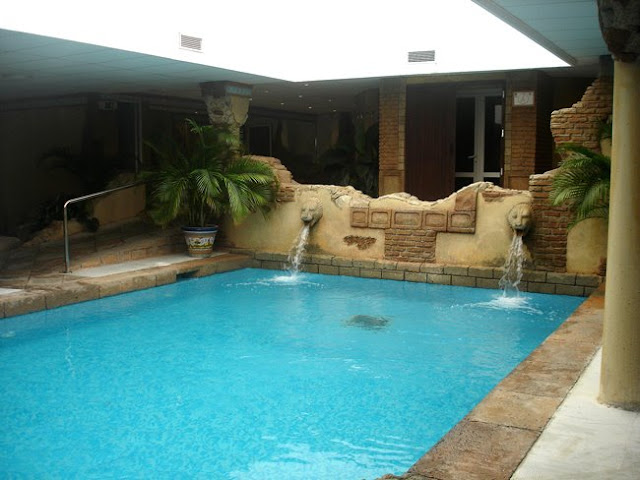 Otro de sus atractivos son los spas que están en Costa Ballena (Rota) a 15 minutos de Chipiona. Yo estuve en uno este pasado finde, el Playa Ballena SpaHotel, pero mi prima, que vive en Chipiona todo el año, me ha dicho que el mejor de todos.
Otro de sus atractivos son los spas que están en Costa Ballena (Rota) a 15 minutos de Chipiona. Yo estuve en uno este pasado finde, el Playa Ballena SpaHotel, pero mi prima, que vive en Chipiona todo el año, me ha dicho que el mejor de todos. es el Elba Costa Ballena que además de un completo circuito de aguas termales, sauna y baño turco, tiene piscinas de agua salada. Pues habrá que probarlo...
es el Elba Costa Ballena que además de un completo circuito de aguas termales, sauna y baño turco, tiene piscinas de agua salada. Pues habrá que probarlo... 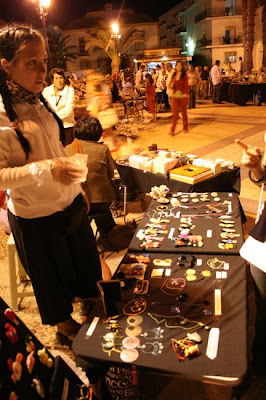
 Sus mercadillos veraniegos son entrañables: antigüedades, productos naturales, artesanía... en un recodo del paseo frente del mar. Todo gracias a la iniciativa de su Ayuntamiento. Mi hermana pequeña se pone allí cada fin de semana y yo estuve allí este finde para admirarla y disfrutar de ese ambiente bohemio para todas las edades. Sus trabajos de fieltro causan estragos en la villa.
Sus mercadillos veraniegos son entrañables: antigüedades, productos naturales, artesanía... en un recodo del paseo frente del mar. Todo gracias a la iniciativa de su Ayuntamiento. Mi hermana pequeña se pone allí cada fin de semana y yo estuve allí este finde para admirarla y disfrutar de ese ambiente bohemio para todas las edades. Sus trabajos de fieltro causan estragos en la villa.
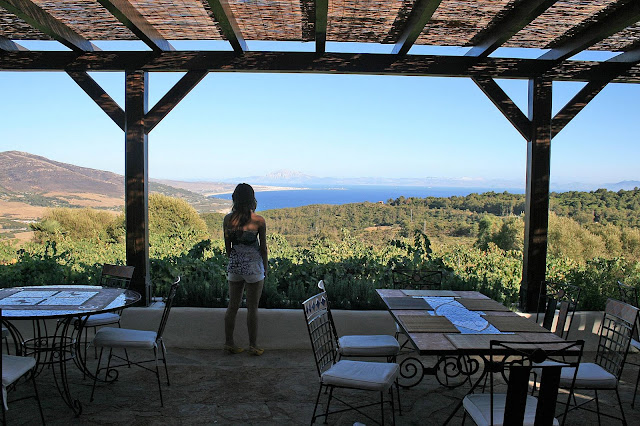 De vuelta a casa pasamos por Tarifa para saludar al hijo mediano de mi marido que trabaja en la Sociedad Gastronómica El Tesoro. Se trata de un restaurante que está en zona montañosa del Betijuelo y desde el que se ve estas preciosas imágenes. Además de por lo bien que se come, puedo entender que haya problemas para reservar allí una mesa. Las vistas de la playa de Tarifa y de la costa de Marruecos son increibles.
De vuelta a casa pasamos por Tarifa para saludar al hijo mediano de mi marido que trabaja en la Sociedad Gastronómica El Tesoro. Se trata de un restaurante que está en zona montañosa del Betijuelo y desde el que se ve estas preciosas imágenes. Además de por lo bien que se come, puedo entender que haya problemas para reservar allí una mesa. Las vistas de la playa de Tarifa y de la costa de Marruecos son increibles.Fotos: David Sánchez Núñez
-----------------------
Chipiona's origin goes back to the Tartesos, when its population was settling itself in areas near Salmedina's Stone. This civilization should have spread between IXth and VIth century B.C., guaranteeing its Empire in the south of Spain, concretly in what today is Chipiona, the Port of Santa Maria, The Portal, and Trebujena, what they all called the island Kartare.
But the time passed and there came the Romans and the consul Quinto Servilius Caepión (140-139 B.C.) build a kind of lighthouse to advoid that navigators, who had to approach the Guadalquivir, had an unwanted "collision" with Salmedina's island. With Turris Caepionis - in honor to its promoter Caepio - they baptized the tower and this way there was in preparation the name of the current Chipiona.
Curiously, Chipiona's lighthouse - constructed between 1863 and 1867- is the highest of Spain and one of The Europa's highest - of 69 meters and 344 steps to rise to the lantern-. The Roman Chipiona turned into a strategic place for the fluvial trade of the Guadalquivir and maritime of Cádiz (known in those days as Gades) where it was blooming the economy of the Roman Spain thanks to the exportation of agricultural products: grapevine, olive tree, cereals; metals; and saltings of Cádiz, principally. As witness of these economic activities still the alfar of The Olive grove remains near the lighthouse, which are the walls of a Roman villa of the 1st century A.D.
Another curiosity, which uses as testimony of the Roman presence in the city, are the tablets and tombs, which occasionally people have found in the beach of Rule - a zone of the coast chipionera near the Sanctuary of which we will speak later - expelled about the sea for the tides. Another historical discovery was the infantile necropolis (s. I-III A.D.) with twenty burials in cut amphorae, that went out to the light after the demolition of an old chalet.
Continuing the historical tour, we come to the Muslim age, that little is known in Chipiona because there are no scarcely documentary witnesses.
What it is known is that it existed a Mosque, probably where now there is the Parish of Our Lady of O, that began being Gothic to impregnate later for the Baroque style, with what it ended up by being a hybrid of great beauty. In its inside, they stand out: the choir´s chairs (the XVIIIth century), the clock of the tower (the XIXth century) and the Gothic sculpture of the Virgin of the Rose - belonging to the Burgundian Sevillian´s School - done by Pedro de Millán to principle of the XVIth.
It is also believed that the Castle - that has happened of having residential use to protection and up to be a hotel - was constructed by the Muslims and about 1295 Don Alonso Perez de Guzmán reconstructed it on its foundations, and give it later to his second daughter Doña Isabel. Recently restored, the building is established on a rocky natural road surface beaten by the waves of the sea when it raises the tide. Don Alonso, protagonist of the Reconquest, was the manager of repopulating Chipiona bringing to several families of the villages of Marchena (Seville), Arcos (Cádiz) and other places for such an purpose, as the chronicles told: "In 1295 the King Mr. Sancho IV gave to Mr. Alonso Pérez de Guzmán el Bueno, chief of the troop and of Tariff, all the land that existed on the coast between The Guadalquivir and Guadalete, in which there were included Sanlúcar, Chipiona, Rota and the Port of Santa Maria, which territory were taken from Jerez -Sherry-".
So, which initially was a simple project of the small one populates, called "Rule of Santa Maria" for the work of the Monastery of Rule - that in those days was constructed - later, it was the definitive project of the future villa, and was called Chipiona honouring its origins.
The origin of Ms of Rule´s the Sanctuary comes from the Ponce of León, Lords of Chipiona, which in 1399 donated the hermits of San Agustín who remained there until 1835. Then, it would happen to be a Franciscans' community that they created there a missionaries' college for Morocco and Holy Land and later, they knocked down the former church and initiated the construction of other one of Neogothic style, between the year 1904 and 1906 that still remains and where the Franciscans actually live. But the prestige that enjoys this sanctuary takes as a center the antique of the image of the Virgin who dates back to the first half of the year 300.
Other curious information of this coastal city: The stay of the Catholic Kings in the Sanctuary of Rule; the disembarkation of the set square angloholandesa, sent by the prince Jorge Darmstadt during the Succession War - in which the chipioneros put on behalf of Philip V-; its almost disappearance of the map for the maremoto of Lisbon; that was the station of baths of the Dukes of Montpensier, spending the summer in it the daughter of these, Maria de la Mercedes, wife of Alfonso XII; and certainly, that was a cradle of the world-famous one, Rocío Jurado, the singer.
Chipiona, is placed to 6 meters of altitude, in the most western part of the province of Cadiz, has 31,99 km2 of surface and approximately 17.000 inhabitants, number that in the summer months doubles for the great number of tourists who visit the city. Other one of its attractions are the Spas. I was in this one last weekend, the Playa Whale SpaHotel, but my cousin, which lives in Chipiona all the year, has told me that the best of all is the Elba Coast Whale Hotel that besides a complete circuit of thermal waters, sauna and Turkish bath, has swimming pools of salty water. Since there will be necessary to try it...
Chipiona´s summer street markets are intimate: antiques, natural products, crafts ... in a bend of the walk in front of the sea. My youngest sister puts there every weekend and I was there last weekend to admire and to enjoy this Bohemian environment for all the ages. Her works of felt cause devastations in the villa!
Of come back home we pass for Tariff (Cádiz) to greet the medium son of my husband who is employed at the Gastronomic Society The Exchequer. It is a restaurant placed in a mountainous zone of the Betijuelo and from that one sees these beautiful images. Besides for well that eats up, I can understand that there are problems to reserve there a table. The sights of the beach of Tariff and of the coast of Morocco (África) are adsolutely incredible.








10 comentarios :
Such a wonderful post with great commentary and photos-truly stunning, well done!!
Thanks Sharon,
You´re really nice ;-)
kss
Me has puesto los dientes largos. Con el mal tiempo que tenemos aquí estos días, ver esas fotos me da una envidia...
Besos
jajajaj pues sí, en Chipiona se estaba más fresquito -no te creas- pero al llegar a Sevilla... 40º. Yo desde luego lo prefiero al frío -es que soy muy friolera-. Aquí hasta noviembre no nos ponemos las medias.
Bsits
;-)
os pasais todo el año viajando? o eso una cosa transitoria de verano?! porque yo también quiero!! qué suerte. las fotos son muy bonitas, dan ganas de ir
Qué va! Lo que pasa es que aprovechamos Puentes, vacaciones y algunos findes para salir por ahí. En cualquier caso, mis padres se jubilaron y viven ahora en Chipiona con lo cual ir allí no se considera viaje.
Ojalá me llevara toda la vida viajando... Creo que no llegaría a cansarme.
Bss atelier
;-)
Qué cuidad más linda!
amo las imágenes!!
Muchos besos!
Kira
Hola Kira,
Sí que lo es y esas puestas de sol... son increibles. Cuanta belleza y cuanta historia detrás.
Bss
;-)
Que pena no haber podido leer esta entrada hace un par de añitos cuando estuvé allí, no me hubiese perdido tantas cosas interesantes. Me gusta tu guía :-)
Gracias por tu visita, y es verdad padres + playa es una buena combinación, yo creo que se acuerdan de cuando eramos pequeños jugando con la arena y nos miman más jeje
Un beso
Hola C.C.
Pues ya sabes, si vuelves, lo que puedes ver -que nunca se sabe-
Gracias por tu comentario
Bss
;-)
Publicar un comentario